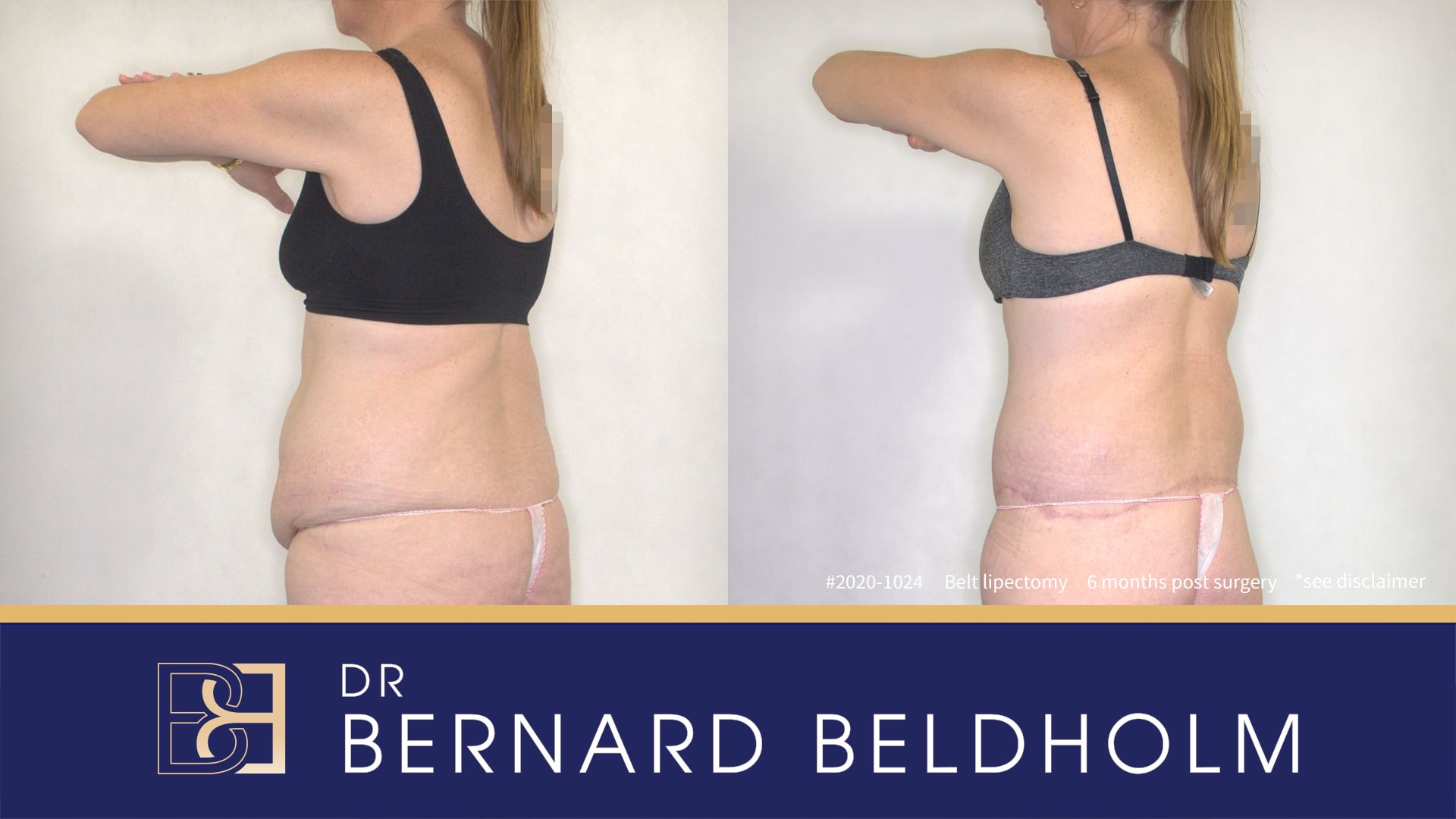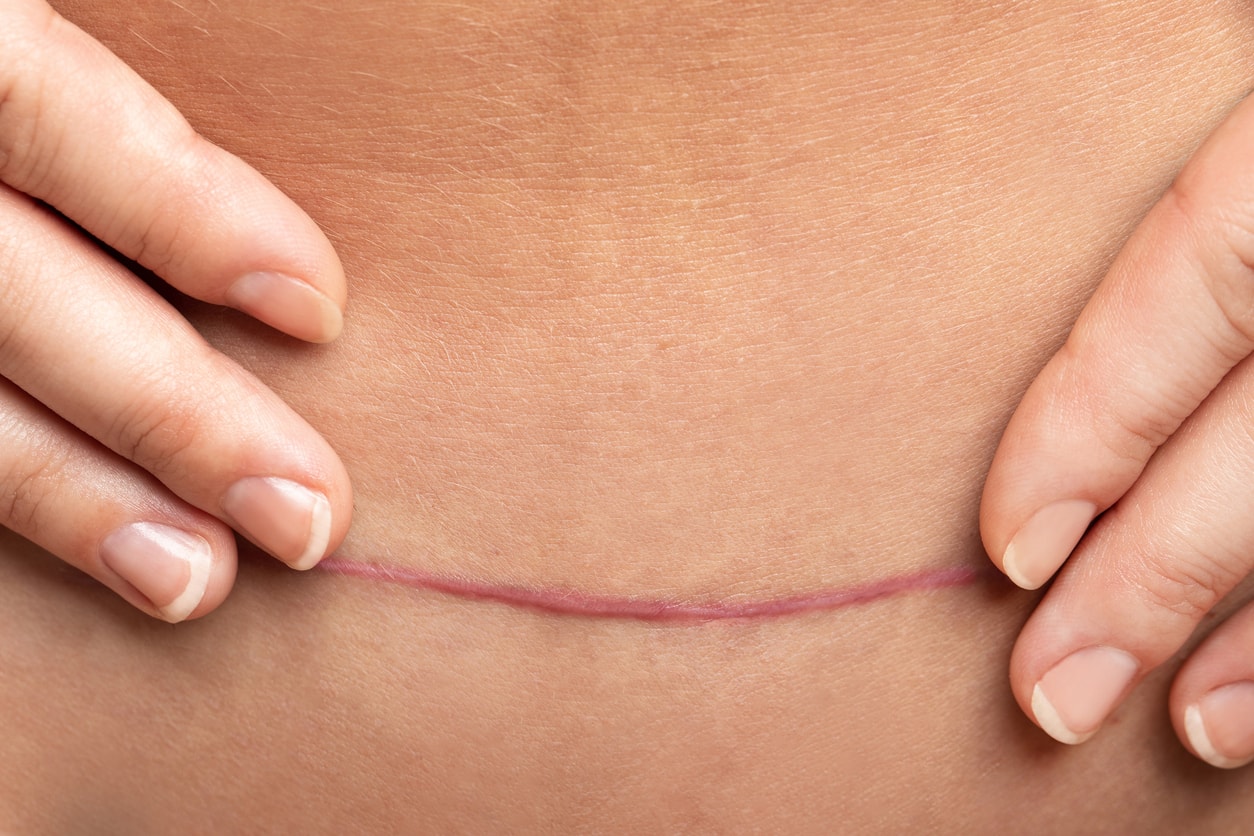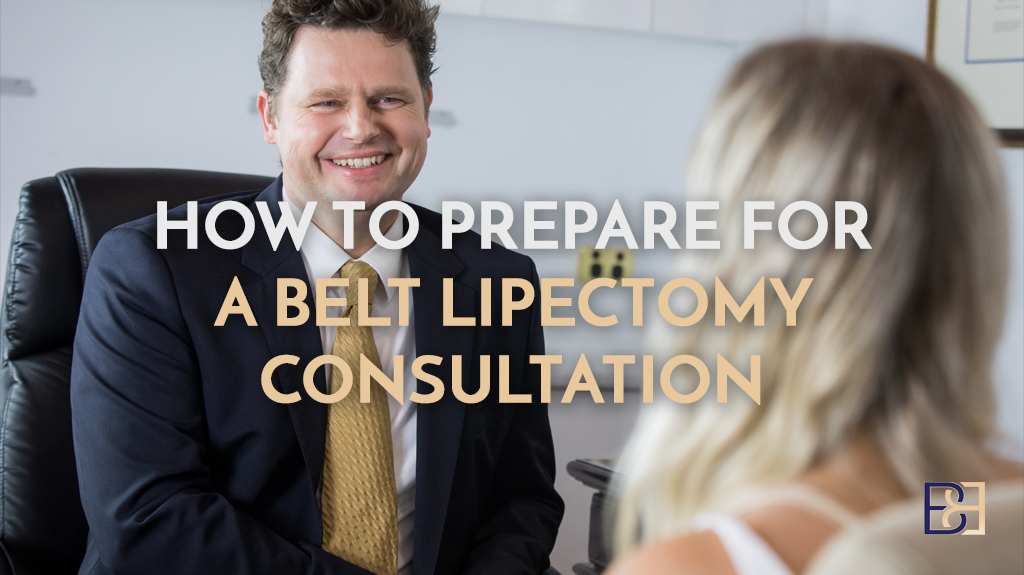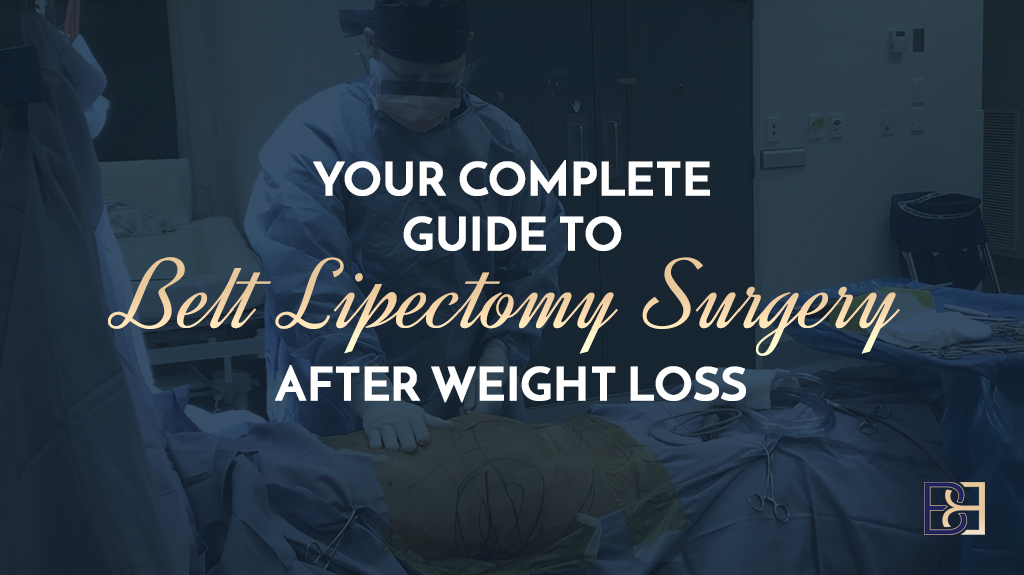Losing 30+ kilos often leaves behind excess skin and fat deposits on the abdomen and nearby areas such as the lower back, hips, thighs, pubic area, and buttocks. Tightening the skin in all these areas is achievable through belt lipectomy surgery, also known as a lower body lift. The surgical scar from this operation is quite long, so taking proper care of it is very important.

Book your appointment online now
What is a Belt Lipectomy (Circumferential Body Lift)?
Circumferential Body Lift (Belt Lipectomy) surgery removes excess skin and fat 360 degrees around the waist after a patient has undergone significant weight loss. It features a circular or circumferential incision, producing a sizable scar. Once the excess tissue is resected, the incision is closed. As with any similar procedure, patients must be at or close to their ideal weight and have maintained it for at least six months before the operation.
Reasons for Undergoing Circumferential Belt Lipectomy Surgery
A Circumferential Belt Lipectomy Surgery is the most extensive body-altering surgery available for post-weight loss patients wishing to remove surplus skin and fat around the waist. It aims to create a flatter and firmer abdomen and well-formed hips, mons pubis, and flank area. At the same time, it also smooths laxity on the upper buttocks and thighs. Some of the main reasons post-bariatric patients pursue this surgery are to remove loose skin, and resolve rashes or hygiene issues caused by excess skin folds.

Tattoo on left breast blurred for privacy
Disclaimer: Operation performed by Dr Bernard Beldholm. Adult content, surgery has risks; individual results vary, seek 2nd opinion. Please see the full disclaimer.
Areas Targeted
A Circumferential Belt Lipectomy targets loose skin and excess fat in several body areas at once.
Abdomen
A Circumferential Belt Lipectomy Surgery includes a traditional abdominoplasty. Your surgeon can tighten the skin on the upper and lower abdomen through the waistline incision. The end result is a tighter and firmer look with fewer skin folds and residual fat deposits. Like a traditional abdominoplasty, your surgeon can also repair abdominal muscle separation, a common trait among formerly obese patients as well as those who have been pregnant in the past.
Hips
Even after reaching your preferred weight, the hips tend to store more fat than other areas of the body. At the same time, it can be one of the more challenging areas to reduce through diet and exercise. Likewise, excessive skin often accumulates in the hips after a patient successfully loses several kilos. With its circumferential incision around the midsection, a belt lipectomy removes and tightens skin circumferentially around the abdomen.
Mons Pubis
The upper pubic area, which lies over the pubic bone, can become slack or protrude after losing a substantial amount of weight. The superficial fat layer that attaches to the underside of the skin can also be challenging to remove through conventional diet and exercise. After a belt lipectomy, the mons pubis will take on a flatter appearance as your surgeon pulls your mons pubis skin upward to close the waistline incision.
Flanks
The flanks are a common trouble spot for many post-bariatric patients. A Circumferential Belt Lipectomy Surgery removes excess skin and fat on the flanks, resulting in smoother-looking skin and fewer lower back rolls.
Buttocks
Although this procedure does not directly operate on this area, a belt lipectomy will help your buttocks to appear more lifted. This occurs as a direct result of the skin being lifted when it is pulled upward to close the incision around the waist.
Thighs
Though it does not directly focus on the thigh area, a Circumferential Belt Lipectomy can reduce extra skin on the outer upper thighs and, to an extent, the inner thighs. The skin is then pulled upward to close the incision around the waist. Any remaining excess thigh skin can be corrected with thighplasty. Due to the extensive nature of the surgery itself, a thighplasty should not be performed at the same time as a Circumferential Belt Lipectomy. It is better to wait at least six months before undergoing a thighplasty to allow the body time to heal between surgeries. For patients requiring both procedures, it’s best to undergo the Circumferential Belt Lipectomy first.

Understanding Circumferential Belt Lipectomy Surgery Scarring
The results and functional benefits achieved with a Circumferential Belt Lipectomy Surgery come with a tradeoff in the form of a surgical scar.
Nature of the Surgical Incision
A Circumferential Belt Lipectomy Surgery scar is a continuous line that encircles the waist. The exact incision placement varies based on the surgical technique. Most commonly, a Circumferential Belt Lipectomy Surgery leaves a scar approximately where you would normally wear a belt. Though a scar is often left behind after deep trauma to the skin, including incisions made during surgery, surgical scars may be hidden beneath undergarments or swimsuits.
Healing Process and Scar Formation
As the skin attempts to heal, cells produce new collagen fibres that weave together. The newly formed collagen matrix results in what we know as scar tissue, which often feels firmer or lumpier than the surrounding skin. Scar maturation can be a long process, typically lasting a year or more.
Expect your belt lipectomy scar to change colour and texture throughout the healing process. If all goes well, the scar should gradually fade from red or brown until it eventually becomes similar to your own skin tone.
Significance of Scarring as a Common Concern for Patients
Many prospective Circumferential Belt Lipectomy Surgery patients are concerned with how noticeable their scar will be once it heals. If you are considering this surgery, please be advised that every patient’s scar heals differently and your surgeon has little control over how your skin remodels as the scar forms.

Tattoo blurred for privacy
Disclaimer: Operation performed by Dr Bernard Beldholm. Adult content, surgery has risks; individual results vary, seek 2nd opinion. Please see the full disclaimer.
What to Expect as Your Scar Heals
Typical Appearance of Scars Post-Belt Lipectomy
Don’t be alarmed if your Circumferential Belt Lipectomy scar initially appears dark, thick, raised, or elevated immediately after suture removal. Your skin is in the earliest phase of scar remodelling and has a ways to go before it will likely become finer in appearance.
Position of Incision, Fading, and Flattening Over Time
Dr Beldholm will discuss what you can expect in terms of the scar fading proccess and scar aftercare during your consultation. Dr Bernard will also carefully plan the position of the incision during the pre-surgical consultation appointment. Though the scars left behind after surgery may be dark, thick, and red at first due to the deep trauma the skin experiences, carefully placed surgical scars can be hidden beneath clothing, undergarments, or swimsuits.
Factors Influencing Scar Visibility
A belt lipectomy may be performed on patients that have significant skin excess due to weight fluctuations, genetics, or the ageing process. In most patients, the mature surgical scar tends to be paler than the nearby skin and is often smooth or slightly shiny once fully healed. Some patients, however, develop hypertrophic or keloid scarring. Raised, wide, thick, or excessively dark or shiny scars are more common among people with darker complexions or a history of poor scarring, which may be genetically predetermined.
Age can also affect how a scar heals. Mature patients may notice their scars are less red and thus appear to fade faster. Though patients under 30 may have a better propensity for scar healing, the scar may stay red longer than it does in more mature patients. Mature patients also have a slightly lower risk of keloid scars developing compared to those in their 20s to 30s.

Surgical Technique and Incision Placement
Before your surgery, Dr Beldholm will show you approximately where they plan to make the beltline incision. The higher they place the scar, the more likely it is to be visible in certain underwear, swim, and clothing styles. If your surgeon’s technique includes liposuction, this may result in additional scars, typically the size of a pencil eraser.

Scar Management Techniques
Post-Operative Care to reduce Scarring
Keeping your incision clean as instructed is a top priority, especially during the first week or two after your surgery. An unclean wound can become infected, which can lead to complications such as deeper infections within the body and wound breakdowns. Necrotic tissue can form, which can result in a worse-looking scar. Additionally, you must also follow Dr Beldholm’s aftercare instructions, which will include avoiding strain on the incision site, strenuous activities such as heavy lifting, and intense exercise will be off limits for several weeks.
Topical Treatments and Products

Your surgeon may advise you to begin a scar care protocol after your wound dressing and sutures are removed. Silicone sheets are often applied to the skin to lock in hydration, which helps the skin cells function optimally as the surgical scars mature. Prescription scar gels are also effective at promoting well-healed scars. Be wary of over-the-counter scar creams and ointments that promise to eliminate scars as many do not contain scientifically tested ingredients.
Massage Therapy for Scars
Two to three weeks after your surgery, after your sutures are removed and your incision has healed, your surgeon may recommend beginning daily manual scar massage, which involves firmly massaging the surgical scar with your fingertips. This process can be repeated daily for six-to-twelve months. Scar massage is believed to help soften scar tissue. (Ref 2) Massaging scars may also reduce scar thickness and reduce discolouration. (Ref 5)
Compression Garments
Although it is a hotly debated topic, some published medical research suggests that wearing a compression garment after surgery may soften the scar tissue and decrease scar elevation. The pressure exerted by compression garments may stave off hypertrophic scars by encouraging the new collagen fibres to grow more cohesively. (Ref 6)
Medical Interventions for Scar Reduction
Non-Surgical Options
- LED Light Treatment: Light therapy may refine the scar’s appearance by decreasing scar redness.
- Silicone Strips: Silicone strips or sheets can be applied after the incision heals to keep the skin properly hydrated as it remodels.
- Laser Genesis: Laser Genesis is an in-office service that heats the dermis to shrink blood vessels, soften scar tissue, and encourage your skin to produce collagen as your scar heals.
- Steroid Injections: Physicians may inject corticosteroids into thickened scar tissue to break apart the densely packed collagen fibres after the scar has had time to mature. (Ref 1)
Surgical Options: Scar Revision Surgery
While scars from a belt lipectomy (lower body lift surgery) can’t be totally eliminated, an asymmetrical or dog-eared scar can be surgically revised to look better in many cases. Scar revision entails refining the scar by creating a new incision and re-closing it.
Preventative Measures and Tips
Importance of Sun Protection
It is essential to keep your scar protected from sun exposure for at least 12 to 18 months. Sun rays are proven to deform collagen and elastin fibres and may also darken the scars, causing them to be more obvious-looking. (Ref 3)
Maintaining a Healthy Lifestyle to Promote Healing
Your lifestyle choices after surgery may have an effect on your scar’s final appearance. A nutritious diet and adequate hydration are key to proper skin-cell function, which is critical during scar healing. Foods such as salmon and olive oil, for example, are rich in omega-3 fatty acids which may support the scar remodelling process. (Ref 4). Zinc and vitamins B and C have also shown positive effects on skin healing, although you must ask your surgeon when it is time to resume taking vitamins and supplements after your operation. (Ref 4) Finally, smoking and alcohol are off-limits for at least six to eight weeks into the recovery process.
Setting Realistic Expectations
Those considering a belt lipectomy should know that significant scarring is inevitable no matter who performs your surgery. Your scar may heal differently from others due to your age, lifestyle habits, genetics, and other factors beyond your surgeon’s control. Your surgeon should speak to you honestly about the scar to ensure you have realistic expectations about what kind of scarring to expect.
Patients who elect to undergo this surgery are usually more concerned with getting rid of excess skin than they are about the scar that is left behind. If you are unwilling to live with a surgical scar, even one that is typically hidden in clothes, this procedure is likely not right for you.
Importance of Choosing the Right Surgeon
Although your surgeon can’t control biological processes that affect how your scar heals, your choice of surgeon can impact your scar’s final appearance. A belt lipectomy is a complex operation that should only be performed by a licensed surgeon who specialises in post-weight-loss body contouring, as they usually have more experience with making neat, discreet incisions.
The consultation process will allow you to get familiar with your surgeon and judge their expertise and credentials. You should ask to see before-and-after belt lipectomy pictures and discuss scar placement, scar aftercare, and scar management with your surgeon before you agree to undergo surgery.
Book your appointment online now
FAQs
How long will my belt lipectomy scar take to heal?
In most patients, scarring tends to fade substantially within 12 to 18 months after the surgery. Scar maturation can take longer in some patients. Surgical scars are not guaranteed to fade, although they often do eventually.
Should I consider scar massage?
Massage is thought to help break up the scar tissue for a flatter, softer scar. Your surgeon can advise you as to the pros and cons of scar massage. Scar massage should never be attempted in the earliest stage of healing. Otherwise, a fresh incision could come apart (wound dehiscence) or bleeding and bruising may be exacerbated.
Can I prevent belt lipectomy scarring?
Scarring from a belt lipectomy is unavoidable. Any time a deep cut is made into the skin, a scar will form. You will need to consider whether a long scar is worth removing excess skin and fat that remains after losing weight.
When should I consider starting scar surgery treatments?
Surgical scar revision should only be considered after the scar has had at least a year or two to mature.
What can I expect as far as results after lower body lift surgery (belt lipectomy)?
As a body contouring surgery, the goal of this surgical procedure is to tighten loose skin and reduce subcutaneous fat that remains after significant weight loss. Once fully healed, you should end up with a flatter, firmer mid-section and smoother-looking skin on your lower back, buttocks, mons, and thighs since it removes large skin folds.
Is a lower body lift the same as a belt lipectomy?
Generally speaking, these two terms are interchangeable.
Can I have another skin tightening procedure on the same day as my body lift procedures?
Loose skin can develop on areas such as the upper arms, face, neck, breast, and thighs in addition to the classic areas targeted with a lower body lift (belt lipectomy) after bariatric surgery or other methods of extreme weight loss. In this case, more than one surgical procedure may be needed to obtain your result. A body lift surgery is a major surgical procedure; Most surgeons recommend performing additional operations, such as an arm lift (brachioplasty) or breast lift (mastopexy) at least six months later.
When is the right time to undergo a belt lipectomy?
The ideal belt lipectomy candidate has already completed their weight loss journey and maintained a stable weight for at least six months before undergoing surgery. If you still need to lose weight, it is better to do it before the operation.
Are body lifts risky?
All surgeries carry a risk of complications, including body lift surgery. To avoid some of the most serious belt lipectomy complications, such as a blood clot that travels to the lungs or a significant amount of blood supply loss, patients should be physically fit, have a body mass index of 35 or less, and follow all their surgeon’s instructions closely. Smokers have increased risks of complications.
References
- “Medical Treatment for Scars & Keloids.” Patient Care at NYU Langone Health, nyulangone.org/conditions/scars-keloids/treatments/medical-treatment-for-scars-keloids. Accessed 28 Aug. 2024.
- Authority. “Massaging a Scar after Mohs Surgery: When Can You Do It?” Dermatology and Skin Health – Dr. Mendese, 16 Feb. 2023, dermskinhealth.com/massaging-a-scar-after-mohs-surgery/.
- Dermatology for Plastic Surgery: Update on Postsurgical Scar Management – PMC, www.ncbi.nlm.nih.gov/pmc/articles/PMC4961501/. Accessed 28 Aug. 2024.
- Impact of Nutrition on Skin Wound Healing and Aesthetic Outcomes: A Comprehensive Narrative Review – PMC, www.ncbi.nlm.nih.gov/pmc/articles/PMC10874171/. Accessed 28 Aug. 2024.
- Lubczyńska A, Garncarczyk A, Wcisło-Dziadecka D. “Effectiveness of various methods of manual scar therapy.” Skin Res Technol. 2023 Mar;29(3) Jan;180(1):207-215.
- National Center for Biotechnology Information, U.S. National Library of Medicine, www.ncbi.nlm.nih.gov/. Accessed 28 Aug. 2024.




